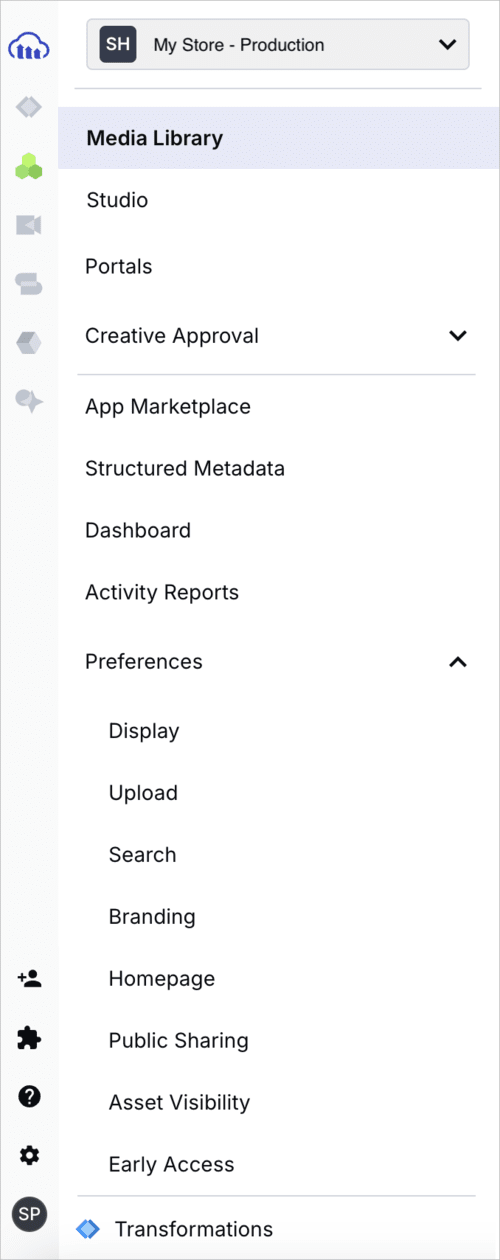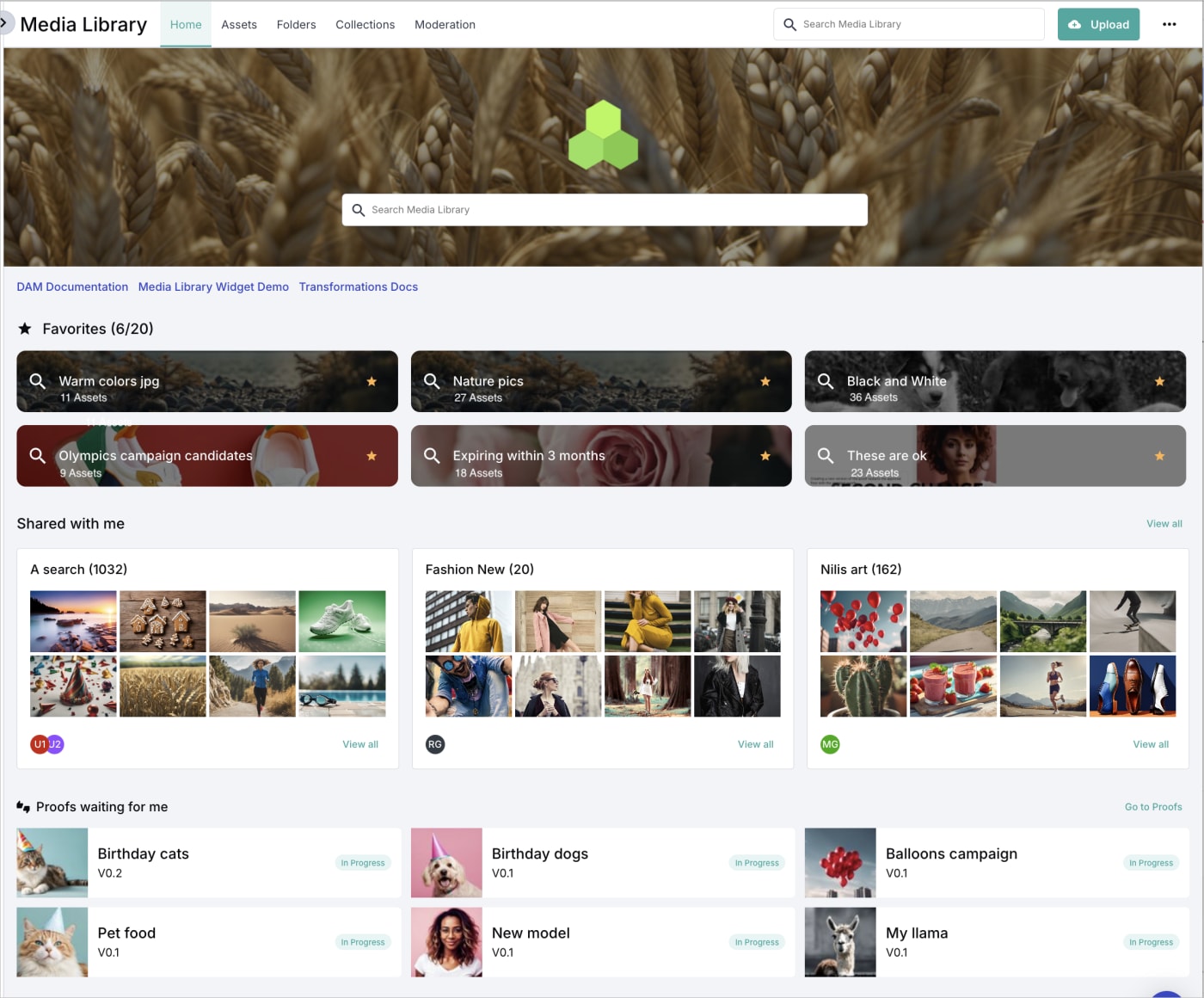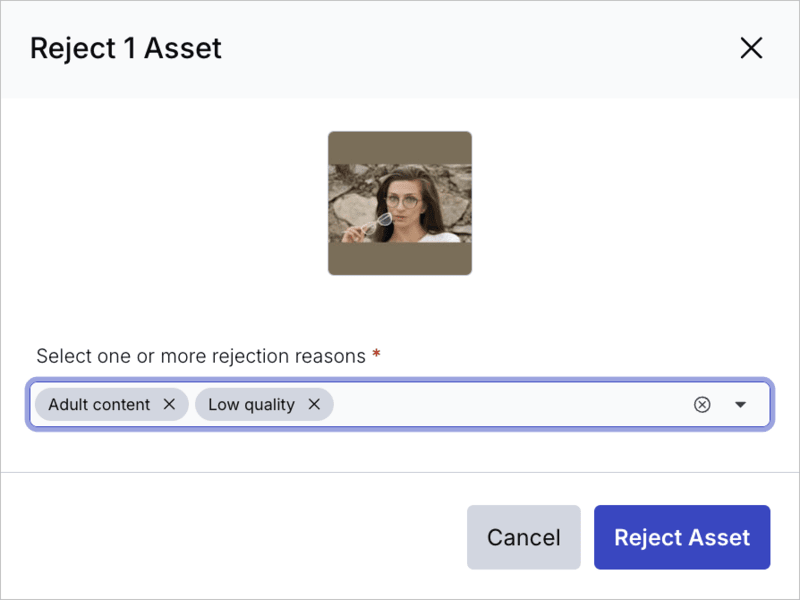Media Library preferences
Last updated: Sep-16-2025
- To learn more about the features available in the Assets Free plan and how they can support development workflows, see Media Library for Developers.
- For upgrade options or more information, contact us.
The Media Library Preferences let you control the behavior and/or appearance of the Media Library for a product environment, such as determining custom metadata display, or defining what's included in the results when you run an Advanced Search. The Media Library Preferences contains the following pages, organized by topic: Display, Upload, Search, Branding, Homepage, Public Sharing, Asset Visibility, and Early Access.
- Media Library Preferences are available only for users with a Master admin role. Changes to these options apply for all users in the product environment.
- Depending on your Assets plan, you may not have access to all Media Library Preferences pages. The sections below explain who can access each page.
- Most of the options on the Upload page of the Media Library Preferences—if available in your account setup—impact only the Media Library experience. However, the Keep existing metadata when uploading newer versions of an asset option impacts both Media Library uploads and the Cloudinary Upload API. Therefore, if your organization also uses the Cloudinary Upload API, make sure that all relevant developers are in sync on the settings of this option, as changes to it could impact applications in production.
To access the Media Library Preferences, select the relevant page in the Preferences section of the Product Navigation menu.
After you modify and save modifications on any page in the Media Library Preferences, logged in users may need to refresh their browsers to apply the changes.
The defaults in the Media Library Preferences provide a good starting place for your Assets activities. However, each organization should review all the available options in the Media Library Preferences pages to determine the options that best answer its needs.
Display
Navigate to the Display page of the Media Library Preferences to set the following display options:
Default landing page
Select the default Assets landing page (Home, Assets, or Folders) that you want all users to see first whenever they navigate to the Assets product in the Console.
Localization
In the Media Library Preferences, you can customize the user interface for your product environment by setting the default display language. The selected language becomes the default language for the Media Library, Manage Structured Metadata page (admins only), as well as for publicly shared collections and basic portals.
Individual users in Assets as well as viewers of publicly shared collections and basic portals can switch languages in the relevant interface.
For users within Assets, the language they select is a global setting that applies to all product environments they have access to.
Primary attribute
You can select a single-select structured metadata field as the primary attribute to ensure its constant visibility to users. This displays the attribute's value:
- Overlaid on asset previews on homepage search results.
- Overlaid on asset previews in Card and Mosaic views and as the first column in List view within Assets, Folders, Collections, and Moderation.
- On the asset management drill-down page.
Furthermore, you can color-code the attribute's possible values (list values) to make it easier to identify specific states.
For example, if there's a structured metadata field or a built-in asset attribute like access control with crucial status that needs to be readily visible in the Media Library, you can designate it as the Primary attribute.
Customize data in List and Card views
As an administrator, you can select key asset details to be visible for your users in List and Card views (up to 4). This empowers users to easily access crucial information. Users maintain the flexibility to select alternative details from the Media Library, if needed.
Here's an example of cards with selected key asset details displayed:
Upload
Navigate to the Upload page of the Media Library Preferences to determine upload behavior.
Always use the folder defined in the upload preset
When selected, if a folder is defined in the selected upload preset, that folder will be used, even if a user drags assets to a different folder.
Require upload preset selection on upload
When selected, a dialog box opens after every upload, requiring the user to select the desired upload preset.
Upload widget sources
You can select which sources are available in the Upload widget from the list of supported options. These may include the local file system (My Files) as well as remote sources (for example, web URLs, Dropbox, or Shutterstock). You can also define the order in which they appear.
Request structured metadata on upload
Choose when to request structured metadata during asset uploads:
Always: Users must fill in metadata fields with every upload. When overwriting existing assets, users can choose to enter new values or keep existing ones.
Only when there are mandatory fields without default values: Users are prompted only when mandatory fields lack default values. When overwriting assets, existing metadata is preserved if no new values are required.
Keep existing metadata when uploading newer versions of an asset
When this option is selected, existing tags and contextual metadata content are kept when users overwrite assets, unless new values are provided. Structured metadata overwrite behavior follows the Request structured metadata on upload setting.
Search
Navigate to the Search page of the Media Library Preferences to set the following search options:
Global search customization
Assets are included in global search results when the searched value is detected within one of the specific areas listed in this section of the Media Library Preferences. For example, conducting a global search for 'shop' retrieves assets with matches in their tags, display names, containing folder, etc. You can optionally choose to include Structured metadata and Embedded metadata in the search.
Advanced Search filter options
You can select and order up to 10 filters that will be permanently displayed in the Advanced Search. The filters that you don't select are still accessible and can be added by the user while performing a search.
Branding
Navigate to the Branding page of the Media Library Preferences to customize your Console as well as shared collections.
You can select primary colors for both dark and light themes plus a custom logo, ensuring they resonate with your brand. Your selections apply to all account users and the collections they share.
Opt for light and dark theme primary colors that contrast well with white or black respectively and that are meaningful to your audience. For instance, avoid colors like red, which is typically reserved for denoting errors.
You can adjust the color and logo selection at any point.
Homepage
Navigate to the Homepage page of the Media Library Preferences to personalize the homepage within the Media Library's Home tab. You can:
- Select a hero image and logo for the top display.
- Choose up to five predefined featured searches to showcase on the Homepage.
- Add bookmarks to external resources for easy access directly from the Homepage.
Public sharing
Navigate to the Public Sharing page of the Media Library Preferences to set the following options for your publicly shared collections:
Publicly shared collection webpage customization
Enterprise plans:
- The Basic portals feature is currently not at enterprise-grade level and is not available for activation. If you have an Enterprise Assets plan and you're looking for a media portal solution, check out our latest portal offering here, and contact our Enterprise Support and Sales team or your Customer Success Manager for more information.
- The collections feature is a premium offering, and its availability depends on your account setup. If collections is not yet enabled for your account and you'd like to enable it, please contact your Customer Success Manager.
From the Media Library preferences, you can customize the dedicated webpages shared with stakeholders outside your organization via publicly shared collections and basic portals.
Download options for external sharing
You can select whether or not the option to download original images and videos will be displayed in publicly shared collection webpages, giving you control over who can access your original files.
-
If you select Remove option to download original images and videos:
- The option to download original images and videos won't be offered.
- This admin setting can't be overwritten when publishing an individual collection or creating a basic portal.
-
If you deselect Remove option to download original images and videos:
- The option to download originals will be offered.
- The option to download original images and videos can still be removed when publishing a specific collection or creating a basic portal.
-
Whether you select or deselect Remove option to download original images and videos:
- Original images and videos can be previewed.
- The option to download original raw assets is offered.
Display attributes in publicly shared collections
You can select which asset attributes, including structured metadata fields, are available in dedicated webpages for publicly shared collections. These attributes serve several purposes:
- Enhancing asset filtering within the shared collection. Filtered results can then be downloaded for improved efficiency when using the publicly shared collections.
- Providing summary information about each asset.
Ensure that the selected attributes that don't expose sensitive information outside of your organization.
Asset visibility
Navigate to the Asset Visibility page of the Media Library Preferences to manage settings that control how assets appear and are accessed within the Media Library.
Hide assets pending moderation
This setting controls whether assets that are awaiting moderation are visible in the Media Library.
- When enabled: Assets pending moderation will only be accessible from the Moderation tab. They're hidden from all other tabs in the Media Library, ensuring that unapproved assets don't appear in search results or general browsing.
- When disabled: Pending moderation assets remain visible across the Media Library, even if they're not yet approved.
This option is useful for teams that require stricter content approval workflows before assets become widely accessible.
Require a rejection reason
To help ensure consistency and accountability in moderation, you can require users to select a reason when manually rejecting an asset.
Here’s how to set it up:
-
Create the reason field
Go to the Manage Structured Metadata page. Add a new single- or multi-select field. Make sure it’s not hidden or read-only. Give it a clear name, such as Rejection reason.
-
Enable it from the Asset Visibility page
Come back to the Asset Visibility page of the Media Library preferences. Under Require a rejection reason, select the field you just created from the drop-down list.
Whenever someone rejects an asset manually, they’ll be prompted to choose a reason before confirming.
Block restricted assets downloads (Beta)
The access control mode feature is a premium offering for Assets Enterprise plans, and its availability depends on your account setup. If access control mode isn't enabled for your account yet and you'd like to enable it, please contact your Customer Success Manager.
When enabled, setting an asset's access control to Restricted prevents downloading it through the Media Library, in addition to blocking it from public access.
This setting helps organizations enforce stricter control over sensitive or proprietary media while allowing for controlled sharing in specific scenarios.
- Admins can still download restricted assets.
- Restricted assets can still be downloaded from portals and publicly shared collection.
Early access
Navigate to the Early Access page of the Media Library Preferences to enable features for your team early, before they become available automatically.
You can opt-in to:
-
Advanced Editor (Transformation Builder) with an improved, simple and easy to use interface.
ImportantThe Advanced Editor (Transformation Builder) is currently:- In Beta, which means there may be minor changes in functionality or appearance before its general access release. We value your feedback, so please feel free to share any thoughts with us.
- Is a premium feature for our Assets product, which means that its availability depends on your account setup. If the Advanced Editor (Transformation Builder) opt-in option is not available to your administrator in the early access section of the Media Library preferences, contact your Customer Success Manager.
- Studio that enables you to apply AI driven transformations to multiple images and save them as templates that can be applied when downloading any image.
 Ask AI
Ask AI







